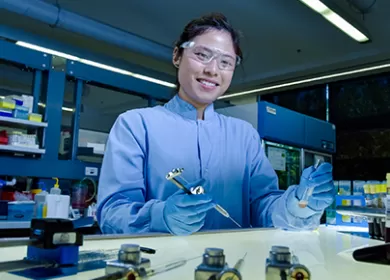Solving rare blood type mysteries
There are more blood types than just A, B, AB and O. Medical mysteries can lead us to new discoveries.
Your blood type is more complicated than you think. There are hundreds of possible variations apart from the commonly known ABO and Rhesus blood groups. Modern genetic techniques allow rare blood variants to be characterised with pinpoint accuracy, and researchers at Lifeblood have used them to solve the medical mystery of a Canadian baby who nearly died at birth.
In 1990, researchers at the National Blood Group Reference Laboratory found a novel antigen on the red cells of a single, very dedicated blood donor named Sarah. The new antigen was named after her: ‘SARA’. SARA didn’t fit into any of the known families of blood group antigens, so a vial of Sarah’s unusual blood was frozen and stored in a blood type archive.
Around 20 years later, Lifeblood received blood samples from collaborators at the Canadian Blood Service which came from a family whose baby had needed a massive blood transfusion at birth. The Canadians thought that this case could be related to the rare SARA antigen and sent samples to Australia for confirmation.
The mother’s plasma was tested against a panel of over 50 archived rare cell types, and reacted only with a sample of SARA red cells. Rhiannon McBean, a doctoral candidate in Research and Development at Lifeblood and the University of Sydney, explained the results. “The father was SARA-positive and the mother was SARA-negative. She had an antibody that reacted strongly with SARA-positive cells. The baby needed a double volume exchange transfusion to recover.”
With the problem identified as SARA incompatibility, a Lifeblood research team, led by Professor Catherine Hyland, set out to identify the gene responsible. Blood and DNA samples were taken from both the Canadian and Australian families, including members from several generations of each family. To identify the gene, researchers first identified the family members who carried the antigen by checking whose blood reacted with the antibody in the Canadian mother’s plasma. The next step was to find a gene sequence shared only by those family members.
“We used whole exome sequencing, which reads the entire coding region of a person’s DNA. It’s a leading-edge technology that wasn’t widely available to the research world even five years ago,” said Rhiannon. The analysis found nearly 500,000 single nucleotide variations in the Australian family, so finding the one variation responsible for the SARA antigen was an incredibly detailed and painstaking task.
Despite the laborious nature of the task, Rhiannon systematically refined the data. “Because SARA is so rare, we knew we were looking for something that hadn’t been discovered before (and) we also had to look for something which fit the inheritance pattern.”
When the final analysis was complete, they discovered that in SARA-positive individuals a single nucleotide had changed in the DNA sequence which encodes glycophorin A, one of the main proteins on the surface of the red blood cell.
The International Society for Blood Transfusion now officially recognises the SARA antigen as a new blood group, and, for the young SARA-positive males in the families, this discovery means that they and their families will be able to successfully manage future pregnancies where the SARA antigen may be inherited.




